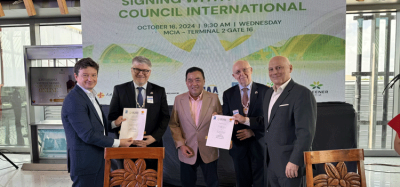The past, present and future of Airport Carbon Accreditation: a Q&A with ACI EUROPE
- Like
- Digg
- Del
- Tumblr
- VKontakte
- Buffer
- Love This
- Odnoklassniki
- Meneame
- Blogger
- Amazon
- Yahoo Mail
- Gmail
- AOL
- Newsvine
- HackerNews
- Evernote
- MySpace
- Mail.ru
- Viadeo
- Line
- Comments
- Yummly
- SMS
- Viber
- Telegram
- Subscribe
- Skype
- Facebook Messenger
- Kakao
- LiveJournal
- Yammer
- Edgar
- Fintel
- Mix
- Instapaper
- Copy Link
Posted: 11 December 2017 | Airports Council International (ACI) Europe, International Airport Review | No comments yet
ACI EUROPE’s Carbon Accreditation Scheme saw an increase of participants to 209 airports, meaning cooperating airports now cover 41.5 per cent of global passenger traffic. We caught up with Marina Bylinsky, Head of Environmental Strategy & Intermodality at ACI EUROPE, to ask her what the future holds for airports going green.


GREEN GROWTH: Momentum is gathering behind Airport Council International’s Carbon Accreditation scheme with the number of participating airports around the world up 21 per cent on last year
So, how and when did the Airport Carbon Accreditation scheme get started?
The foundations of the programme were laid by European airports. In the early 2000s, they were gradually coming to a realisation that their environmental efforts, so far focusing largely on air quality, noise, water and biodiversity, needed to be complemented by a broader action against climate change.
In November 2007, the Airports Council International World (ACI) General Assembly in Buenos Aires has adopted a resolution, which concluded a commitment “… to reduce carbon emissions, with the ultimate target of becoming carbon neutral”. Following this major step, in June 2008, the annual assembly of ACI EUROPE adopted a landmark resolution on Climate Change which outlined the same commitment, but also went a step further, as it stated that a tool to enable airports to achieve this goal will be put in place. This development happened in alignment with the work on the global aviation industry goals within Air Transport Action Group, that were formalised in 2007 as well.
One year later, again at their annual assembly, ACI EUROPE launched Airport Carbon Accreditation, a programme specifically designed to assess and recognise airport efforts to manage and reduce their carbon emissions. This is how Europe became the cradle of Airport Carbon Accreditation.
To gauge the programme’s immediate success, by the end of the second reporting year, there were already 40 accredited airports in Europe and that was 2010-2011, a very difficult time economically. Airport Carbon Accreditation has expanded beyond Europe for the first time in 2011, when Asia-Pacific region of ACI decided to step in. Only 3 years later the movement for CO2 reduction at airports reached a fully global span, with ACI Latin America becoming the final region to adopt the programme, at the end of 2014.
How do you go about assessing airports? Is it through visits or submissions etc.
Airport Carbon Accreditation acknowledges that airports are at a number of different points on a journey towards carbon neutrality. Performance recognition is ensured with four ascending levels of accreditation: Mapping, Reduction, Optimisation and Neutrality. The airports can apply for any level of the programme, provided they demonstrate sufficient evidence of their eligibility
The levels gradually assess airports based on their carbon emissions inventory (Level 1 Mapping), evidence of effective carbon reduction (Level 2 Reduction), widening the scope of their carbon footprint to include a range of Scope 3 emissions and presenting evidence of engagement of other (third party) stakeholders in the reduction efforts (Level 3 Optimisation), and eventually, offsetting the residual emissions from sources over which they have direct control, using internationally recognised offsets (Level 3+ Neutrality). It’s important to note that an airport can only reach a higher level of accreditation, once it has fulfilled all the conditions of the previous steps.
Especially, moving up to Level 3+ Neutrality is governed with stringent rules. To reach this level, airports must first demonstrate that they have achieved significant carbon emission reductions at the facilities they operate and have engaged other stakeholders on the airport site (airlines, ground handlers, retailers, etc.) to lower their own carbon emissions. Those efforts have been and continue to be very significant – with airports investing millions in implementing more energy-efficient infrastructure and low emissions technologies, for instance through fleets of electric cars and buses, photovoltaic parks, LED light bulbs and much, much more. It is only once such measures have been implemented that airports can move to carbon offsets to compensate for their residual emissions.
The data collection and reporting on carbon emissions is done by the airport itself. The various data and information presented in each airport’s application, must be checked by an independent third party verifier, before the application is submitted to the programme administrator (WSP).
The administrator then assesses the application and subject to their assessment, the airport is recognised with a certificate at a level which corresponds to their performance.
This system ensures that the accreditation process remains stringent and unbiased
How do you work with airports to improve their rating?
We don’t really refer to the stages of the programme as a “rating”. Our idea is that each step that airports take towards a more comprehensive carbon management matters. However, if we speak about learning, there are numerous opportunities created for airports within the programme to gain new insights on carbon management.
The environmental aspect of airport operations, unlike the route development or financial aspect, isn’t necessarily a source of competition among airports (although they do pay attention to each other’s certifications!). We have noticed that there is a good amount of spontaneous knowledge and best practice sharing between airports.
On top of that, through various communications, ACI aims to inspire and keep the participants informed. For example: every year, several airports are invited to share their latest initiatives in terms of carbon management in the Case Studies section of the programme’s Annual Report, which is widely available for download on Airport Carbon Accreditation’s website.
On a more frequent basis, ACI issues AirportCO2 News, a newsletter aimed at updating the accredited airports and other stakeholders on the developments within the programme. This also puts a spotlight on innovations implemented by fellow participant airports.
ACI also encourages airports that are part of the programme to take part in the Airport Carbon Accreditation Task Force, a body composed of airport representatives, attached to the Environmental Strategy Committee of ACI EUROPE, but open to representatives from other regions as well. The Task Force keeps watch over the robustness of the programme and shares ideas as to how to accommodate the evolution of climate action over time.
You’ve seen a substantial growth in the number of airports joining the scheme in the last year, what do you think has driven this growth?
The rapid growth on the global scale of the programme is an indication that airports recognise the value of joining the AirportCO2 community. Last month, we broke the barrier of 200 accredited airports worldwide!
The global nature of climate change is bringing a new kind of exposure and challenges to industries that have a high environmental impact or significant emissions and aviation is certainly one of them. According to the Intergovernmental Panel on Climate Change (2001), it contributes around 2% of global man-made CO2 emissions, a number which is expected to increase in the coming years. It is estimated that airport activities account for up to 5% of total aviation emissions. The pressure to act upon one’s own emissions is particularly hard on the aviation industry. Furthermore, the effects of climate change are becoming increasingly palpable for the airports themselves. Acting against climate change us thus a matter of business continuity for airports. This year, we saw the first airport from a small island state ranked as highly vulnerable to the effects of climate change join the programme. Nadi International Airport in Fiji became accredited at Level 1 Mapping.
On another hand, participation in the programme brings about many benefits. Airport Carbon Accreditation is a tool enabling airports to contribute to national and international climate goals. Another aspect to consider is that shareholders are increasingly paying attention to the sustainability of companies they invest in. This way airports’ participation in the programme makes a business case as well. The initiatives aimed at reducing carbon emissions are often a source of important savings in terms of energy use, which translates to less spending in general.
Apart from the efficiency gains, there are also less tangible, but ever so important, improvements. For instance, the airports that reach Level 3 Optimisation are obliged to develop a stakeholder engagement program. We have seen airports benefit from the work they put into this cooperation enormously. Gathering the many companies operating at the airport around a common goal of reducing the overall emissions creates new synergies among them, spurs brainstorming and gives rise to a brand new – greener – airport-wide working culture. In this sense, Airport Carbon Accreditation is a useful tool for generating new efficiencies and driving awareness among airports, but also, indirectly, among the companies operating at their premises.
Are there any challenges facing airports as they work towards reducing their carbon footprint that they didn’t face five or ten years ago? Has there been a movement, discovery or idea that has been repeatedly pushed into your consciousness in the last year or so?
It is difficult to draw general conclusions with the participant airports differing so greatly in all ways possible. In the programme, there are airports of different sizes, geographic locations, types (commercial, general aviation, cargo, etc.). They are faced with different legal and environmental factors as well. Naturally, the challenges they face are of various nature.
However, something they have in common is that each year, to be re-accredited, as of level 2, they must demonstrate new emissions reductions. The requirement level thus increases as “the seniority” of an airport in the programme increases, because it becomes more and more difficult for an airport to identify new emissions reduction options.
Referring to your second question, the technology landscape is changing fast and making much progress, also in terms of carbon management. However, there is no one solution that could be singled out as revolutionary. The Internet of Things technology, new-generation solar panels, more efficient electric vehicles or state-of-the-art biofuels are all pieces of the CO2 reduction puzzle, not the puzzle itself.
If not, how has it been made easier for them to become more green? Is it down to technology or awareness?
It’s definitely a healthy mix of both. Technology and awareness work as connected vessels. Investments in more eco-performant equipment is not necessarily going to render major gains on its own. A significant shift in the company culture has to happen side by side with the investments. Fortunately, they also spur one another. The employees’ willingness to “greenify” their ways is often triggered by the management’s decision to invest in cleaner energy or devices, and a sort of a “virtuous circle” is set up!
Green technology itself is becoming more and more affordable as its use is growing. Almost ten years ago, when the programme was in its early stages, solar panels or electric cars were eyed with reluctance, more as an expensive gadget, than a technology that was going to revolutionise our energy production and expenditure. Nowadays, although the cost is still significant, they are on the verge of becoming mainstream in some regions of the world. However, access to low-carbon energy sources and technologies differs quite significantly globally.
What in your opinion is the key thing holding airports back from performing well on the scheme?
Again, I would like to stress that airports at every level can perform well. Airport Carbon Accreditation is not a ranking system.
However, if I were to pinpoint a matter that might constitute an obstacle for some airports, I would look towards the question of resources. Airport Carbon Accreditation is a rigorous and demanding programme. Some smaller airports can find it challenging to have all the resources and metrics required for putting together an application.
Taking that into account, the Airport Carbon Accreditation Task Force has been brainstorming on how to address this issue. An idea of bigger and more experienced airports helping out smaller ones is currently under discussion.
If you could jump forward 10 years, what would you expect/reasonably hope to see in airports approach to sustainability and environmental responsibility?
In 10 years’ time, we will be excited to find out how European airports delivered on their pledge to reach 100 carbon neutral airports by 2030 J. Some already believe that they might not only beat the clock, but also beat this number.
We would like to see carbon management and focus on sustainability to become a norm at airports around the globe, as natural to airports’ operations as any other activity. If the number of Airport Carbon Accredited airports will keep the same pace of growth, we might well get there!
Related topics
Airport Carbon Accreditation (ACA), Airport development, Emissions, Sustainability


















